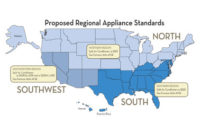 After much debate, new regional standards for HVAC equipment have become a reality. On Oct. 25, the Department of Energy (DOE) confirmed that it adopted new residential appliance standards for central air conditioners, furnaces, and heat pumps. According to the new rule, the country will be divided into three regions, and the minimum efficiency standards for these appliances will vary depending on the region they are installed in. The new rules become effective in May 2013 for non-weatherized furnaces, and in January 2015 for weatherized furnaces, central air conditioners, and heat pumps.
After much debate, new regional standards for HVAC equipment have become a reality. On Oct. 25, the Department of Energy (DOE) confirmed that it adopted new residential appliance standards for central air conditioners, furnaces, and heat pumps. According to the new rule, the country will be divided into three regions, and the minimum efficiency standards for these appliances will vary depending on the region they are installed in. The new rules become effective in May 2013 for non-weatherized furnaces, and in January 2015 for weatherized furnaces, central air conditioners, and heat pumps.The announcement was met with mixed reaction by the industry. The Air-Conditioning, Heating, and Refrigeration Institute (AHRI) applauded the new standards, while the Air Conditioning Contractors of America (ACCA) and Heating, Airconditioning & Refrigeration Distributors International (HARDI) expressed disappointment in the ruling.
The New Regions
According to the new rule, the country will be divided into three regions — North, Southeast, and Southwest — and the minimum efficiency standards for each equipment type will vary by the region in which it is installed. In the North region, most furnaces will be required to have an AFUE of 90 percent or more. In the Southeast and Southwest, central air conditioners will be required to have a SEER of 14. Heat pump and oil furnace standards will rise on a nationwide basis.
The Northern region comprises states with population-weighted heating degree days (HDD) equal to or greater than 5,000. This includes Alaska, Colorado, Connecticut, Idaho, Illinois, Indiana, Iowa, Kansas, Maine, Massachusetts, Michigan, Minnesota, Missouri, Montana, Nebraska, New Hampshire, New Jersey, New York, North Dakota, Ohio, Oregon, Pennsylvania, Rhode Island, South Dakota, Utah, Vermont, Washington, West Virginia, Wisconsin, and Wyoming.
The Southeastern region comprises states with population-weighted HDD less than 5,000. This includes Alabama, Arkansas, Delaware, Florida, Georgia, Hawaii, Kentucky, Louisiana, Maryland, Mississippi, North Carolina, Oklahoma, South Carolina, Tennessee, Texas, Virginia, and the District of Columbia.
The Southwestern region comprises Arizona, California, Nevada, and New Mexico.
For the complete specifications of the new standards, see Figure 1 (click on the PDF link below).
Industry Reaction
As reported in The NEWS last month, DOE accepted public comments on its regional standards rulemaking from June 27 until Oct. 17. After reviewing the comments, DOE stated that “the adverse comments received in response to the direct final rule do not provide a reasonable basis for withdrawing the direct final rule.” DOE then confirmed the standards as effective on Oct. 25.
This decision upset many members of the industry, especially organizations that had submitted their concerns about the rule to DOE. Jon Melchi, manager of government affairs at HARDI, said, “We are disappointed that the DOE has decided to move forward despite the objections of HARDI and many others. HARDI has long viewed this rule as bad for our industry, and especially for the many small businesses that make up two-thirds of the HVACR supply chain and were excluded from this process.”
Similarly, ACCA expressed disappointment about DOE’s decision. According to Charlie McCrudden, vice president of government relations, “ACCA is extremely disappointed that DOE chose to use a fast track process in promulgating new energy conservation standards for residential HVAC equipment.” He continued, “By using the direct final rule process, DOE ignored the legitimate concerns of the stakeholders who filed comments urging the agency to take more time to consider all concerns. ACCA remains concerned about the implications on cost, safety, and energy efficiency by requiring condensing furnaces in the Northern region.”
However, AHRI released a statement that applauded DOE’s confirmation of the new rule. According to Stephen Yurek, AHRI president and CEO, “This effort has been underway since 2009, and we are pleased DOE has made a final decision so we can move forward as an industry to comply with the new standards.”
After legislation was passed by Congress in 2007 that granted DOE the authority to establish regional standards, AHRI organized an industry coalition of HVAC manufacturers and energy efficiency advocates that developed consensus agreements for regional standards. DOE then adopted the language of the consensus agreements in its direct final rule. Now, the certainty provided by DOE’s confirmation of the standards will enable manufacturers to get ready for the 2013 and 2015 implementation dates.
Power Modes
However, manufacturers are concerned about the rule’s standards for standby- and off-mode power. According to Yurek, AHRI hoped that DOE would remove the standby power requirements and put them into a separate rulemaking. “For furnaces, they [DOE] have completed the test procedures, so we know how to measure what standby power requirements are. For air conditioners and heat pumps, they have not finished those procedures yet,” he explained. “While we would have preferred the department sever the off-mode standard from the direct final rule, we will work with DOE on the test procedure.” According to AHRI’s statement, its members will continue to review these standards and “work with DOE on the test procedures with which the manufacturers can determine compliance.”
Figure 2 (click on the PDF link below) shows DOE’s new requirements for standby mode and off mode levels for residential furnaces, and the requirements for off mode levels for air conditioners and heat pumps.
Enforcement: Still Unknown
One question that remains unanswered about the new standards is how they will be enforced. “The industry is now facing an unprecedented regional standards scheme with an unknown enforcement plan,” McCrudden said. “Looking forward, ACCA plans to work with our industry partners on the pending DOE enforcement rulemaking to minimize the hardship and liability of regional standards on the small business contractors of the HVAC industry.”
Melchi added that HARDI is going to “turn our attention to the enforcement rulemaking, which is forthcoming, and attempt to make the best of a bad situation and find a reasonable solution to the enforcement part of this rulemaking.”
According to Yurek, DOE has asked the industry to come forward with a proposal for how to enforce the regional standards. He said AHRI is committed to working with ACCA and HARDI to develop an enforcement plan that will place a “minimal amount of additional burden on the contractor.”
Listen to the McCrudden NEWS podcast at http://bit.ly/r5aPwc.
Publication date: 11/14/2011








